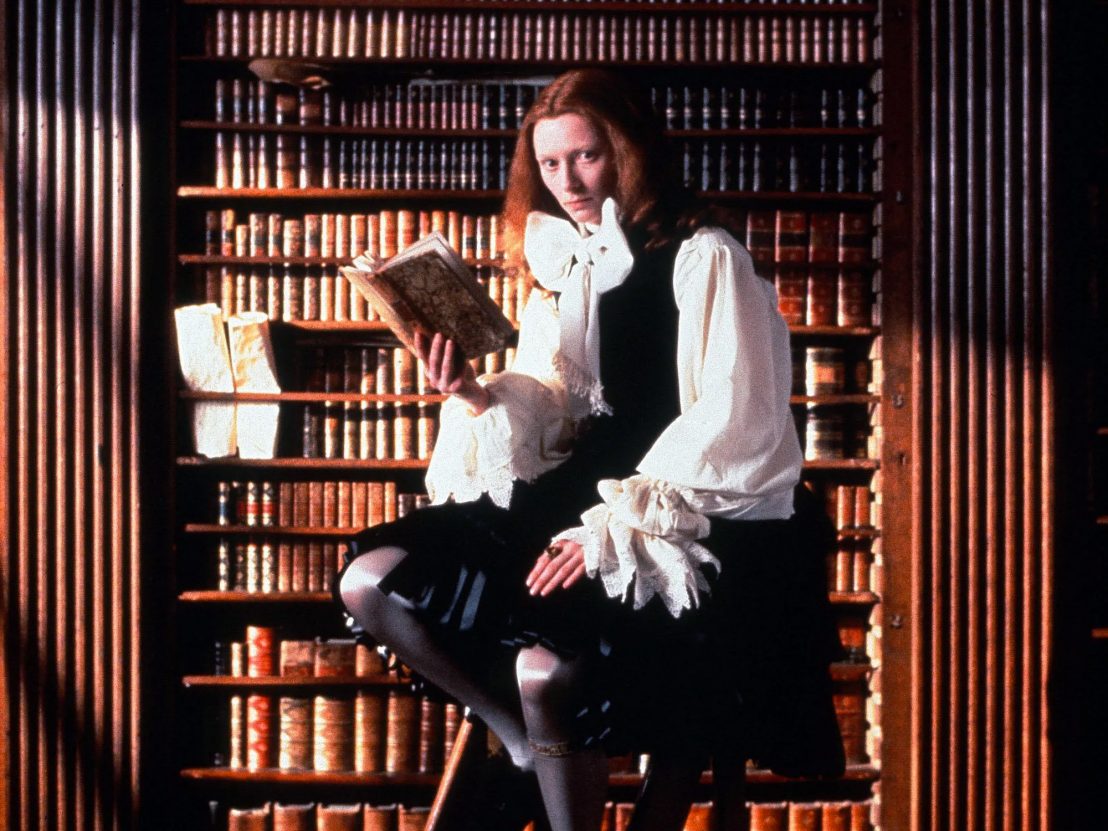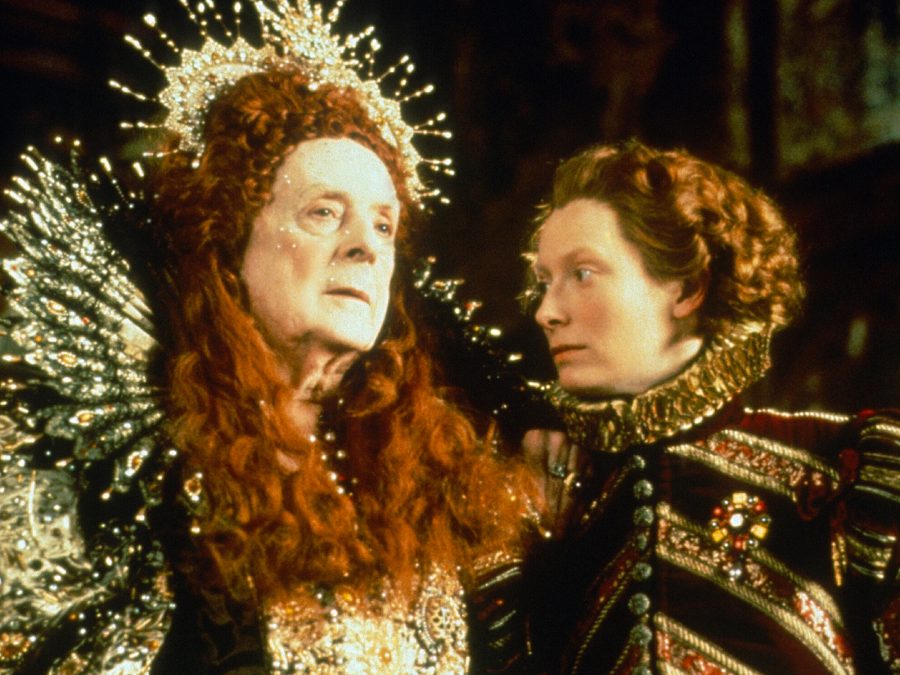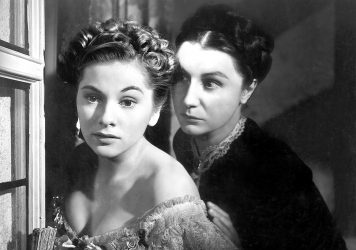
From the very beginning, Sally Potter’s film adaptation of Orlando brings the body of its title character to the foreground; the opening lines of narration argue that “there can be no doubting his sex.” But the thing that animates Orlando the most is this very idea of doubt; that in spite of the surface level appearance of Tilda Swinton’s title character, and all the assumptions that come with it, and in spite of the fact it can’t be doubted at first glance, that the truth below the surface is more nuanced.
The complexity of gender – how it’s presented, performed, and what it means to appear as one binary gender or another – go to the heart of Orlando. Even before being blessed with something like eternal youth, there are striking visual parallels between the “male” version of Orlando, and the female Queen Elizabeth (played by Quentin Crisp). Mirrors and echoes, both in visuals and dialogue, are one of the ways in which Orlando the film is able to explore the inherently non-binary nature of Orlando the character.
The visual parallel between Orlando and Elizabeth is powerful not just because of the ways in which it challenges the idea of what performing gender looks like – with a female actor playing Orlando, and a male one playing the queen – but also by highlighting the idea of visual similarity between characters who are presented as either male or female; in doing this, Orlando able to carve out a space for its eponymous hero(ine) that’s able to exist in-between the two binaries that are embodied by Orlando and Elizabeth in the film’s opening section. It’s this glee in subverting expectations around gender that turns Orlando into something explicitly non-binary, a rarity in even contemporary queer or trans cinema.
The “male” version of Orlando is also a subversion of gendered norms in cinema; even more so than after their transformation/transition, it’s the first iteration of the character that’s most often gazed at, and treated as an object of desire; even when Orlando is mourning the passing of Elizabeth, other members of the congregation argue that “mourning so becomes him,” even in his “time of grief.”
The way that this version of Orlando is seen and treated by those around them creates a cinematic shorthand with the feminine; in spite of the fact that they look male – possessing, ironically, what the narration calls the “feminine appearance that every young man of the era aspires to” – the world around them responds in a way that’s normally reserved for female characters: to be looked at, treated as an object of desire.

It’s desire that holds a fascinating mirror up to Orlando’s gender, and the ways in which it’s informed by the way that they’re presenting at the time; after being rejected, they decry “the treachery of women,” something that they go on to echo as “the treachery of men” in their post-transformation life. It’s after these incredibly gendered moments, evoking or decrying the binary ideas of man and woman, that Orlando looks out at the camera; there’s something knowing in that sly smile, a way of saying to the viewer “I’m not like that.”
Even as some dialogue, from the treachery of (wo)men, saying something as simple as “I adore you,” is echoed throughout, it’s the way in which Orlando presents and is perceived that informs the kind of impact that these things have. Orlando is a film about this kind of presentation; its reflections and limitations. And it would be impossible to talk about Orlando without talking about the transformation that divides both the film and its title character; on the surface, it’s this seemingly overnight change from “man” to “woman” that would mark the film as trans; with this transformation acting as a kind of transition. But the importance of the language used after Orlando gazes at their new body in the mirror challenges the idea that this is simply a move from one binary state to another: “same person. No difference at all. Just a different sex.”
It’s this constant challenging of what being “male” or “female” looks or acts like that allows Orlando to move in the direction of both a gendered representation, and kind of cinema, that’s explicitly non-binary. Orlando doesn’t become a new person after their body changes; what’s interesting is instead the way in which the rest of the world sees them, and how moving through the world in a body seen as male impacts the ways in which this new version of Orlando responds to these perceptions and expectations.
They immediately break boundaries in their new body by going alone to events where it’s assumed a woman would have a partner or chaperone of some kind; they challenge the ways in which their male company discuss and deride women. This is more than just the idea of Orlando becoming a “strong woman,” or exercising independence in a way that’s surprising for a woman, but instead about the ways in which moving through the world in different bodies has allowed them to find their own, unique kind of liberation. It’s no wonder that one of the things that’s most compelling to Orlando is the advent of trains, described as “the sound of the future.”
The final narrative coup of Orlando comes through a moment of stunning self-awareness. The title character, now living a contemporary life, has a meeting with a publisher about a book that they’ve written: the story of their life. From the very beginning, Orlando has been a self-aware story; the opening narration is disrupted when the title character directly addresses the camera, breaking the voice-over. But more than just being a continuation of these ideas, the end of Orlando reveals that it’s always been about Orlando themselves telling their own story, refusing to fall into the simple and binary categories that the world often tries to put them into.
It’s through this continued disruption of expectation, first planted at the very beginning of the film, that Orlando is able to present itself as something radically trans – their “maleness” exists in tandem and tension with the ways in which they’re often treated as a more “female” object of desire, just as the post-transformation character wouldn’t exist without the earlier chapter in their life. These ideas of echoes and history – and the ways in which Orlando challenges the limits of these ideas – all come to a head when they finally return to the home that was once theirs, centuries ago.
When their eyes meet the Elizabethan portrait in their likeness, it captures how Orlando has transcended the expectations and the image staring back at them; that this moment of stillness, consigned to history, is something that has been able to stay alive and keep transforming. These final moments of transcendence, from Orlando looking at that age-old portrait, to the angel that seems to visit them and their child, reveal a figure who has always been telling their own story, in an act that still remains radical.
Support our independent journalism and receive monthly film recommendations, exclusive essays and more
Become a memberPublished 12 Mar 2022

Woolly dialogue undermines a strong cast and intriguing plot in Sally Potter’s drab drama.

The late Icelandic composer’s Last and First Men was completed posthumously.

By Eleanor Ring
The 1940 adaptation of Daphne du Maurier’s novel sees the title character refuse to be tamed by marriage.